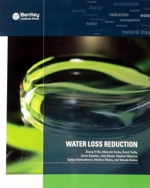
 Water is a valuable resource. As the world population continues to grow and urban development continues to expand, cities are expanding and water infrastructure is demanding greater attention. Leakage is a primary contributor toward water loss. As a result, water agencies, engineers, urban planners and officials are developing strategies to deal with this problem. Leakage modeling and detection technology are being applied to water loss issues. Written by many professionals from around the world, the book Water Loss Reduction attempts to inform, educate and help to provide answers through better management to contend with infrastructure water loss.
Water is a valuable resource. As the world population continues to grow and urban development continues to expand, cities are expanding and water infrastructure is demanding greater attention. Leakage is a primary contributor toward water loss. As a result, water agencies, engineers, urban planners and officials are developing strategies to deal with this problem. Leakage modeling and detection technology are being applied to water loss issues. Written by many professionals from around the world, the book Water Loss Reduction attempts to inform, educate and help to provide answers through better management to contend with infrastructure water loss.
Water Loss Reduction
by
Zheng Yi Wu et al.
ISBN: 978-1-934493-08-3 284 pages
(English)
Review by Jeff Thurston
Zheng Yi Wu is Bentley Fellow, Director, Applied Research for Bentley Systems. His work has largely surrounded issues of hydrology, water management, hydroinformatics and computational simulation. This book brings together his insight, experience and knowledge together with a wide range of authors involved in water management for infrastructure. Their combination of knowledge provides readers with a wealth of information about managing modern day water infrastructure – with a focus on water loss.
The book begins by identifying the availability of freshwater around the world – or rather the lack of it. Fully 97% of the world’s available water is sea water, of the remaining 3%, about 2.5% is frozen and the balance of 0.5% can be found in aquifers, rainfall, lakes, reservoirs and rivers. As A.B. Cleveland Jr. says, “meeting the demands for infrastructure coverage and quality within limited budgets with limited resources requires innovation.”
Short of generating more freshwater, most of this innovation can be expected to take place due to conservation and improved water management. Water loss can be seen to exist in each of these, since conservation is about retaining what already exists – and avoiding leakage. Water management on the other hand brings forward issues related to infrastructure design, construction, operation and maintenance. Systems management through simulation and modeling are components of these phases.
Losses can be apportioned through different pathways. These include physical losses through pipes and infrastructure, commercial losses through handling – metering and unbilled or unauthorized consumption. The opening chapter describes these losses and shifts to the benefits of improved management that can be realised, such as improvements in energy savings, reduced carbon footprint and environmental and social factors.
Graphics depict infrastructure assets for water and the authors include background to describe the individual processes involved in water loss. This book quickly heads into the heart of the matter, discussing water loss occurence, while defining non-revenue water and the scale of the water loss problem.
Top-down real assessment losses, bottom-up real loss assessments and component analysis all lead toward a discussion of water balance throughout a network. The book is informative for the information it includes such as a description of 24-hour water system functioning and how variable it is. Issues of zonal measurement and monitoring, pressure management and leak pin-pointing are outlined. The management of water leaks and data connected to these leakage areas is also managed and described.
Hydraulics, leakage coefficients, leakage flow and other parameters are also discussed. Hydraulic models form the basis of water leakage studies and monitoring. These models, when operating optimally, can lead to the detection of leakage within water infrastructure. The book includes a detailed description of how these models can be applied and includes an example of such an application.
Included are maps to describe hydraulic modeling. Areas being investigated are represented to assist the reader to understand and appreciate the influences and decision making across entire networks and their relationships. Transient Analysis is described and additional methods such as Time Domain approaches for evaluating networks are included.
A section on field data capture includes insightful information about what to look for when it comes to assessing field data and how different kinds of data characteristics often represent particular kinds of leakage issues. Also included are information pertaining to real-time monitoring and SCADA systems for water management. An example outlines changes within data being collected and how they can be assessed – in this case 195 alerts are represented and dealt with. Final chapters of the book deal with pressure management and the need for planning and replacing water infrastructure.
In summary, this is an excellent book that describes water networks and their management. In many ways I think this book could be used for general education and undergraduate studies, while also serving as a reference for water management specialists. It effectively outlines the issues relating to water leakage in networks and the means for assessing and monitoring them.
The graphics in this book while readable, could be be larger, particularly the aerial images. I wondered if color maps would not better describe the water networks as well.
Water Loss Reduction is a an excellent starting point for those responsible for assessing, monitoring and managing water networks. Clearly the authors experiences show through in this book, vastly improving knowledge sharing. The inclusion of field data-to-office approaches and system integration details, mean that this book applies throughout water enterprises.